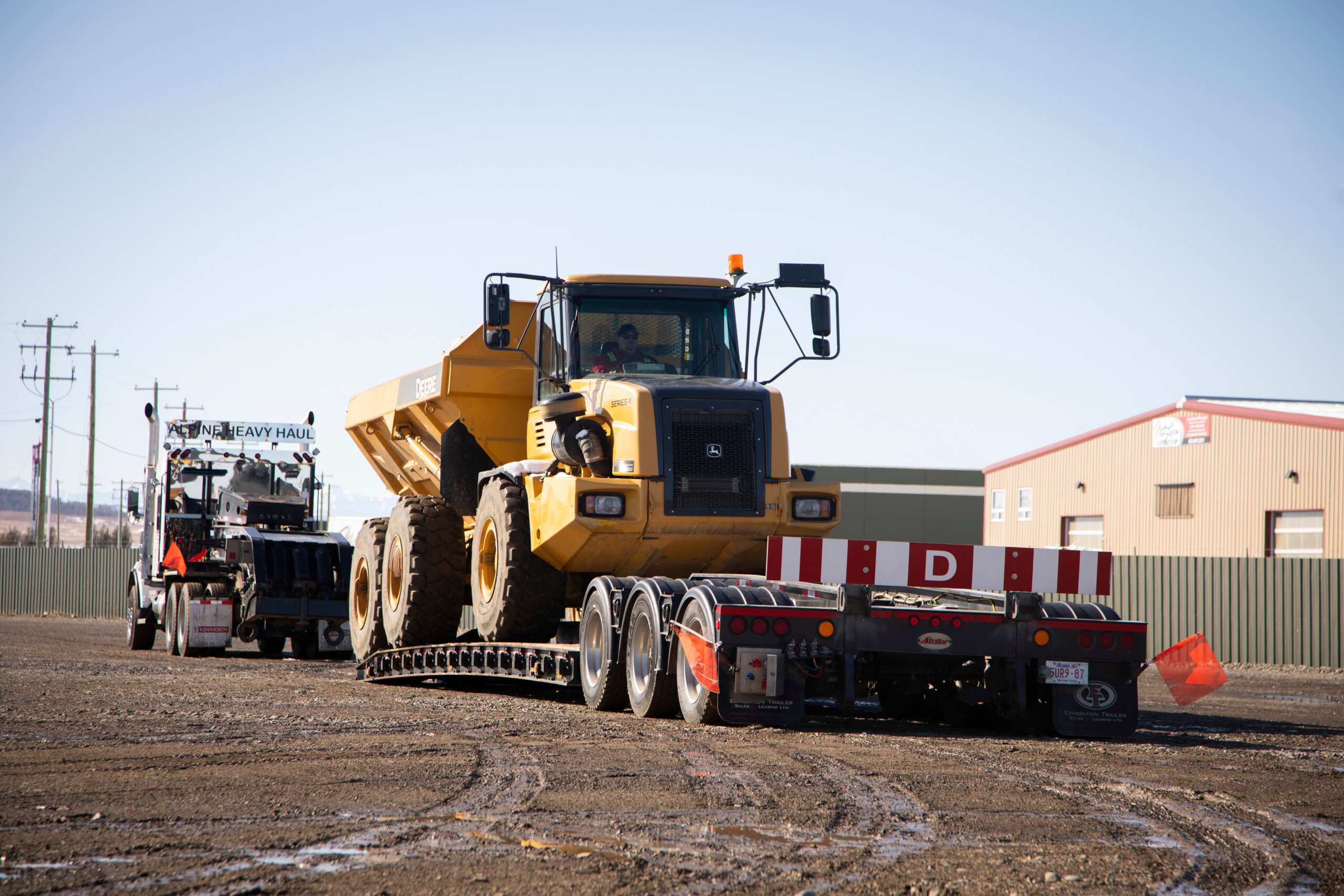Understanding Trailer Types in North America
Get To Know the Heavy Equipment Transport and Trailer Types Used in North America.
Many customers wonder how our drivers will pick up and deliver their heavy equipment shipments across Canada and the United States. The trucking industry has various trailer options designed for different-sized loads with a range of maximum weight and other specs. Depending on the load you need to have shipped, the type of trailer the driver will use will vary from extendable flatbeds to removable gooseneck trailer (RGN) to step-deck trailers. Your driver will use the right trailer for your type of freight to ensure safe transport.
For example, if you are looking to ship a midsize or large combine, your driver will likely require an RGN-type trailer. Perhaps you need to have a backhoe hauled. Your driver might use a step deck with ramps, a smaller gooseneck tandem, or a tri-axle trailer to make the delivery.
This page will help you understand what the owner/operator will use and why. It will help you understand the process, especially if you have multiple items or are figuring out how much deck space the load might take when creating your quote using our calculator tool to get a free quote on shipping costs.
Why understanding trailer types in North America is useful when hauling heavy equipment
When you learn about the types of trailers used to transport heavy equipment in North America, you will also gain an insight into:
- How a driver will load the equipment.
- How the load will be secured.
- What the maximum weight is for particular trailer configurations.
- What the trailer can usually accommodate (so you know the driver uses the correct equipment for your load).
- Gain a consideration for drivers operating costs (heavy hauling impacts fuel and insurance rates for high value-high risk loads). Oversize loads also require route planning, possible special permits, and even pilot escorts.
To help you visualize the different types of trucks and trailers that might be used, we’ve created a resource below to explain what type of trailers our drivers use to transport different types of heavy loads.
Browsing through the trailer types below will give you an understanding of what to expect from our heavy haulers for your shipment. Each type of trailer is described by what they can haul, how the driver loads your items, and how the load is secured.
You can also check out our drivers in action to see recent loads we’ve helped to connect. You can also learn more about the costs of heavy equipment shipping to help you prepare.
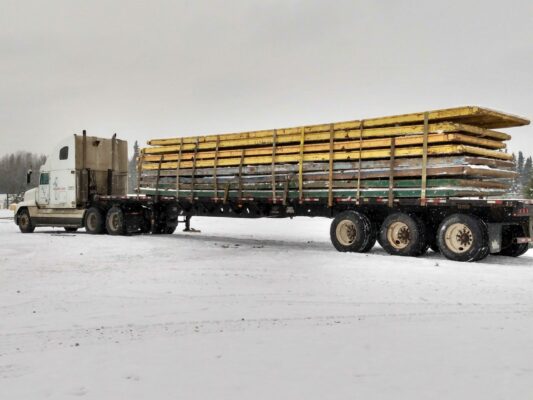
Flatbed/Highboy Trailer Type
The flatbed/highboy trailer is one of the most common trailers you might see out on the roads.
Length: 48’ – 53’ Long deck
Width: 8’ 6”
Height: Deck Height 60” (5’)
Weight Capacity: 48,000lbs
These are mainly used for hauling loads of material and equipment.
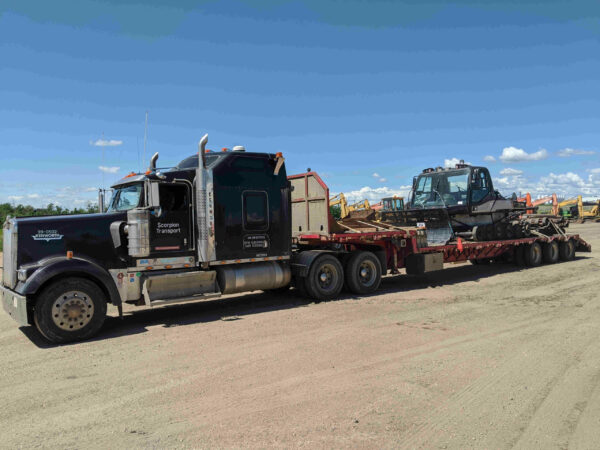
Step Deck Trailer Type
Also known as a Single Drop
Length: 48’ – 53’ most common. There are some variations though with these trailers ranging from 35’ – 63’ the top deck or neck will be typically 11’ long with the lower deck 37’ – 42’ and sometimes longer. Trailers can be Tandem or Tridem (how many axles they have) and that can change the allowable weight capacity, because more axles means a greater weight can be accommodated. Multi axles allow that weight to be distributed.
Width: 8’ 6”
Height: Deck height 60” and the bottom deck typically 42”
Weight Capacity: 43,000lbs – 62,000lbs
The lower deck can handle loads that are too tall to be transported using a flatbed/highboy, but still, need the length. A good example would be, Telehandlers, Loaders, Construction Equipment. These trailers are easy to load and unload. Not all have ramps but the vast majority of our drivers do. That’s why they can load easily.
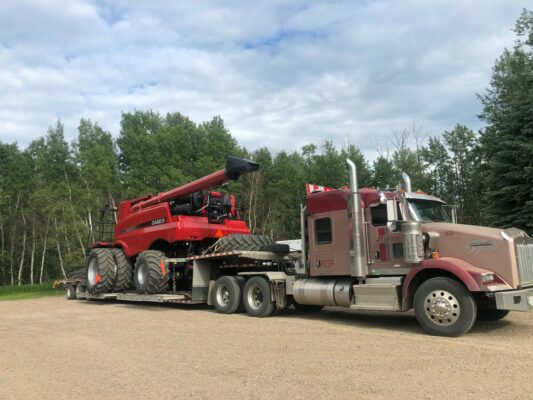
Double Drop Trailer Type
Also known as a lowboy, or double drop lowboy, and detachable’s
Length: 48’ Long, the upper decks typically 6’ – 10’ and the lower deck (bottom well) about 30’ – 32′
Width: 8’ 6”
Height: 18” to 24“
Weight Capacity: 43,000 lbs – 58’000lbs depending upon number of axles. Expandable’ s can carry even greater weight and have longer wells.
The trailers can typically carry the tallest loads. These are used to haul Construction equipment, Wheel Loaders, Rock Trucks, Bulldozers, oversized/large vehicles, tanks, cranes etc. Typically, loading from the rear. Some Trailers will also feature ramps known as Beaver Tails. Attached at the rear of the trailer and stowed vertically.
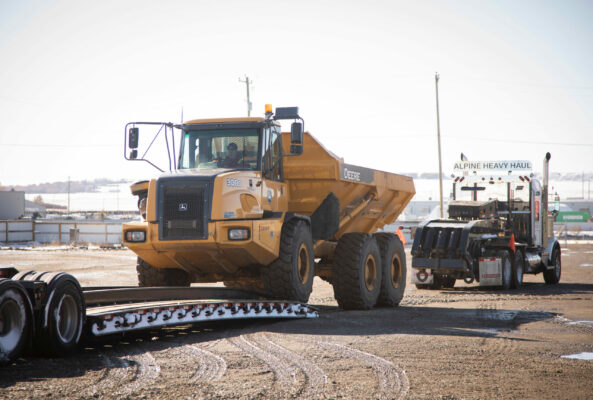
Removable Goose Neck (RGN) Type Trailer
Length: 24’ – 29’ main deck
Width: 8’ 6”
Height: 18” to 24“
Weight Capacity: 42,000 lbs – 150,000 lbs dependent on the Lowboy trailer and number of axles.
RGN’s can be double drops and lowboys, so RGN trailers do vary quite a bit. This type of trailer neck can be removed. Allowing the Semi Truck to detach from the trailer, lowering the trailer, so it can then act as a ramp. The equipment gets loaded at the front of the trailer and is very low. Typically, used to transport long heavy motorized equipment, such as Bulldozers or Excavators, for example.
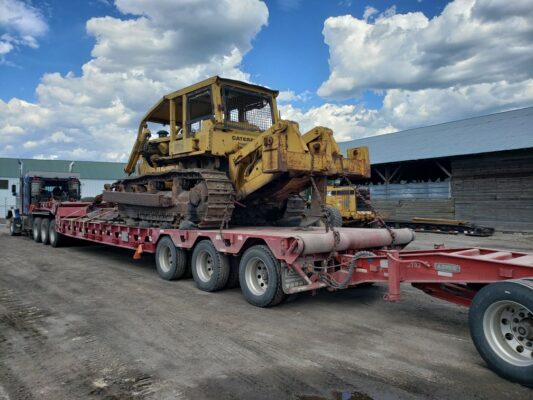
Booster, Jeep Trailer Equipment Types
You might hear the driver talk about booster jeeps. In short, when a driver is hauling a very heavy load, they are required to spread the weight in order to not damage the road or wreck their equipment. Using extra wheels or booster jeeps, allows the driver to safely haul heavy loads without breaking laws and, being unsafe, or damage the roads. These can attach to the semi-truck directly, then the loaded trailer attaches to the booster, you may even find another booster on the tail of the loaded trailer
Securing the load
One of the most important aspects of the entire shipping process is loading and securing the heavy equipment. If no loading assistance is available this responsibility will fall to the driver. He is always going to ensure the load is secured regardless.
Our community of Owner Operators actually have the necessary years of experience and qualifications to operate the many different types of equipment our customers require to be hauled.
Loading your heavy equipment
Lets assume we have a RORO load, (roll on roll off) When loading the driver will carefully drive the equipment onto the deck. Some perpetration to the trailer might be required, for example detaching the RGN neck from the semi truck as mentioned above.
Once on the deck the driver may carefully reposition to ensure the weight is distributed correctly across the trailer and over the axles. That’s because he needs to ensure the load and trailer is balanced so it’s safe for transport, and is legal. If you are preparing equipment for transport you might find our ready to ship guide helpful too.
Chaining Down
Now that the equipment is on the trailer deck the driver will start the process of chaining down. Typically he will use the tow eyes of the heavy equipment and tie down to specific points on the trailer deck and the trailers rails. Each trailer differs as you now know. And the same applies to tie down points. Certain Step Decks for example are not suited to heavy equipment but are more suited to shipping materials that need closer together tie downs, like multiple crates and pallets, as opposed to to a dump truck. Remember that our drivers will not accept to haul loads that they cannot accommodate.
You may also see drivers securing with straps too, to give extra security to the load.
Final Checks
Once the driver is satisfied the load is secured he will drive away at a low speed and brake to check the load stays in the desired position. Now it’s ready to head to the drop off location.
Heavy Equipment in Transit
During transit the adept trucker will stop and check the load is still safely secured and make adjustments if necessary. Also Drivers are required to stop at weigh scales. Weigh scales are recording the overall weight and axle weights. If these are over what the truck and trailer are rated for or of the driver is not permitted to haul this weight, he will be fined and possibly face other consequences.
Why you can trust Trusted Dispatch
Our community of truckers know the rules and regulations and do not just load and go hoping for the best. These are some of the most experienced and professional truckers available so they will not only look after your load but their trucks, trailers and livelihood and reputation.
Three Steps to Easier, More Affordable Heavy Haul Shipping
Get Started for Free.
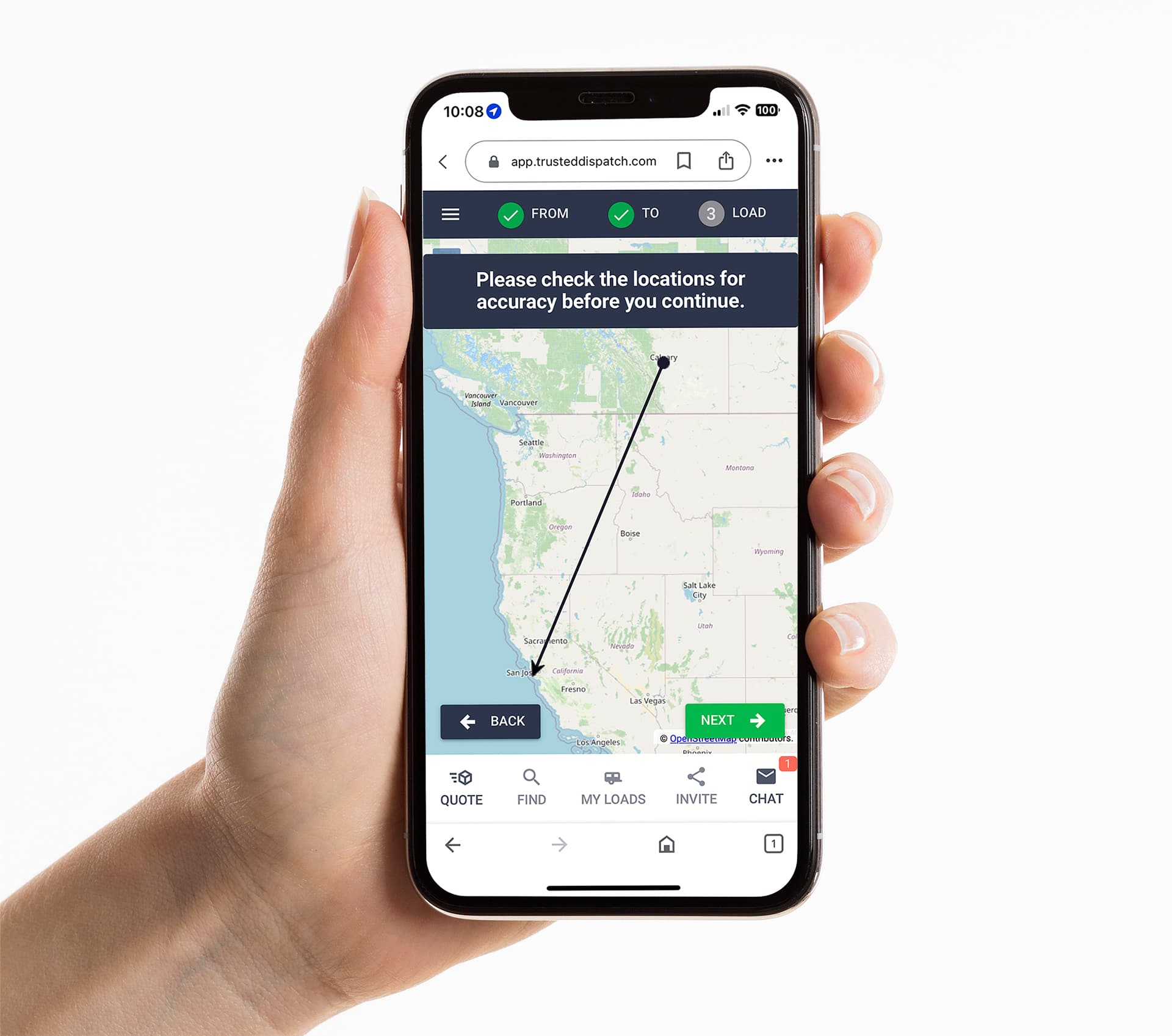
Receive a Free, Instant Quote
Use our calculator to find out how much it will cost to ship your load. Input your pick-up and delivery locations and find the dimensions and weight of your equipment with our simple equipment specs tool. Receive your quote in seconds.
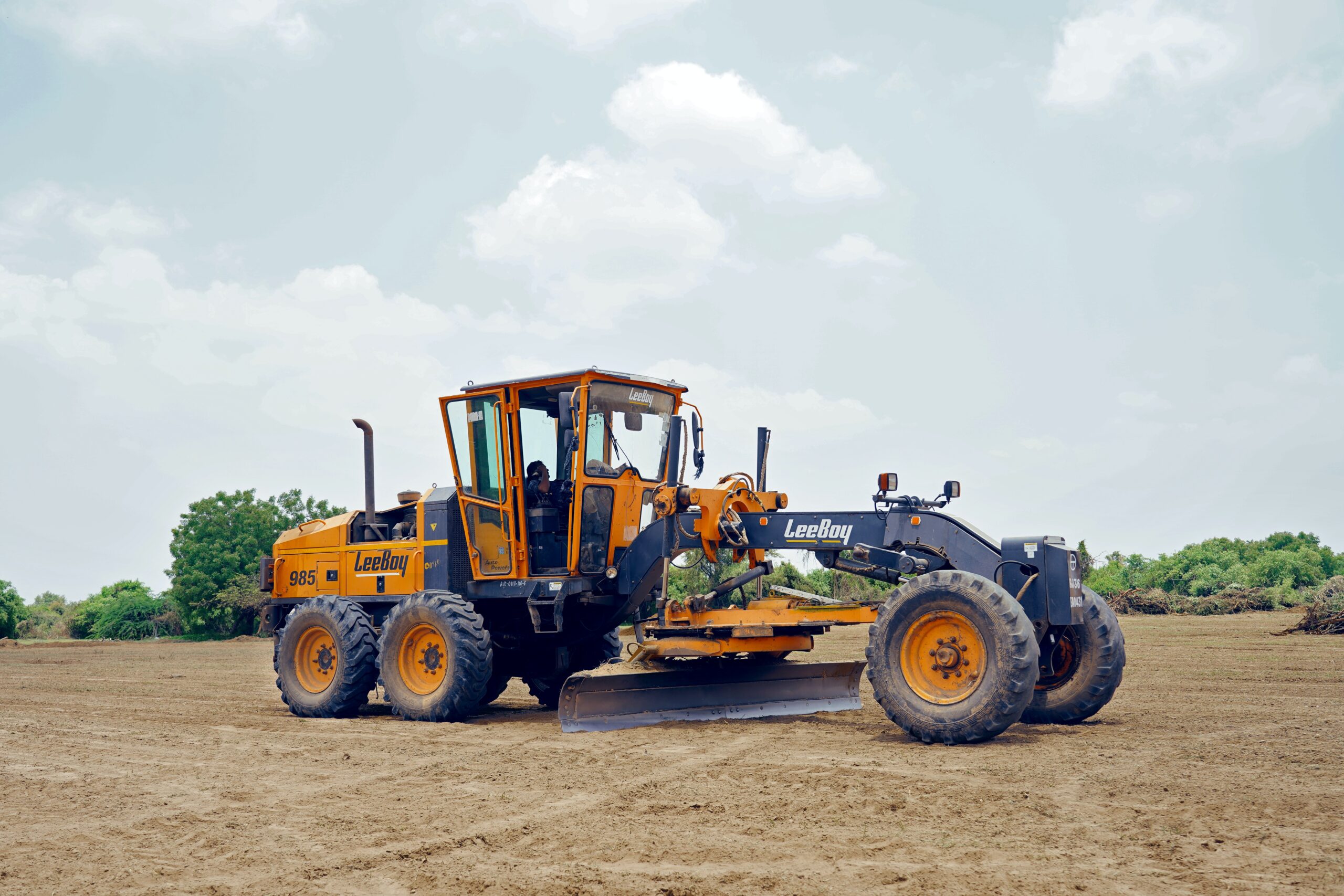
Publish Your Load For Free
